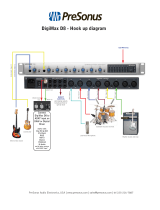
17
level to the stem recorder. You can use the METER-FADER-SETUP parameters
to control the output level of BUSS 1-8 for monitoring.
When a mix snapshot is stored on the master, a mix snapshot is also stored on
the slave simultaneously. The same is true for saving automation mixes.
However, when these files need to be cleared from the DM-24 to make room for
new mixes, these files would have to be transferred individually from each DM-24
to an external MIDI device for storage.
The stereo buss, control room and studio outputs on the cascade slave can be
used independently of the cascade master. This allows many benefits. For
instance, the stereo buss on the cascade master could be output dry while a
compressor could be inserted on the stereo buss of the cascade slave. With 2
AES/EBU, S/PDIF and balanced analog outputs, up to 6 stereo mixes could be
output simultaneously. The control room and studio outputs on the cascade
slave could be used to feed different monitors systems. Use the cascade master
for your standard near field monitors and studio speakers, while the cascade
slave could feed midfield speakers and small computer speakers. It is always
nice to reference wide variety of different speakers when mixing. Cascading
makes this easy.
One DM-24 allows you to very easily record and monitor 16 tracks
simultaneously. However it does not allow you to monitor with effects or setup
cue mixes with effects. Cascading two DM-24 makes for the ultimate 24-track
recording/monitoring system. Let’s say you have an MX-2424. Plug tracks 1-16
into the master DM-24 via TDIF. Plug tracks 17-24 into TDIF-1 on the slave DM-
24. Recall the RECORDING 1-16 snapshot on the master and the slave will
follow. At this point, the system is ready to record and monitor 32 tracks. Go to
the I/O screen on the slave and assign EFFECT 1 L&R and EFFECT 2 L&R to
channels 25-28 and assign nothing (----) to channels 29-32. If you have MIDI
modules assign their outputs to line inputs 9-16 on the slave. Mic/line inputs are
already assigned to channels 9-16, but channels 9-16 are assigned to DIRECT
outputs at the moment. Instead, assign them to the STEREO buss. It would be
wise to make stereo pairs out of channels 25-32 as the outputs of the MIDI
modules are stereo. So now we have:
•
24 mic inputs assigned to direct outputs on channels 1-16 on the master and
1-8 on the slave. Each of these channels has a gate, compressor, 4-band EQ
and 6 aux sends.
•
24 tape returns assigned to the stereo buss on channels 17-32 on the master
and 17-24 on the slave. Each of these channels has a compressor, 4-band
parametric EQ and six aux sends.
•
The outputs of the internal effect processors are assigned to channels 25-28.
Each of these channels has a compressor, 4-band parametric EQ and 6 aux
sends.
•
Our MIDI sound module outputs are plugged in to line inputs 9-16 on the
slave and assigned to channels 9-16. Each of these channels has a gate,
compressor, 4-band parametric EQ and 6 aux sends.



















